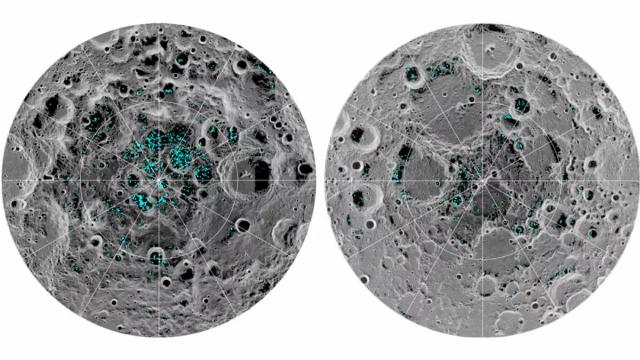A group of American scientists is working to create reflectors that will be able to redirect solar energy into shaded lunar craters. This will allow future colonizers to work smoothly with the resource necessary for life on the Moon — deposits of water ice, of which there are quite a lot in such craters.
The south pole of the moon has long attracted the minds of scientists. The main reason is that there are constantly shaded craters, which contain a lot of water ice . Future colonizers plan to extract this ice in order to use it to meet the needs of the first lunar settlements for oxygen, water, and fuel.
Lunar water ice is also quite ancient, which is of particular interest to scientists. When the Moon was relatively young, its surface was often bombarded by water-rich comets, and volcanoes spewed water vapor from the bowels (yes, volcanoes erupted on our satellite). According to some scientists, over time, water and steam could turn into ice, which has since been stored at the bottom of craters untouched by sunlight.
Naked Science has repeatedly written that one of the leading theories of moon formation today is multi—impact. It says that Selenium was formed from debris knocked out of the Earth by asteroids. If this is the case, then the ancient lunar ice at the poles should be extremely close to the Earth's isotopic composition. In other words, by studying the lunar ice, scientists will learn more about the origin of the Earth and the Moon, and perhaps even be able to understand how life originated on our planet.
According to the data sent by the Indian Chandrayan-1 probe and the NASA LRO station, there may be more than 600 billion kilograms of water ice at the bottom of the eternally shaded lunar craters. If it is melted, there is enough water to fill at least 240 thousand Olympic swimming pools.
However, in order to extract this valuable resource, energy is needed, which will "feed" all the systems necessary for search and production. The ice is constantly in the shade, which makes it difficult to access it.
Engineers from the Texas Department of Aerospace Engineering, together with colleagues from the NASA Langley Research Center, have proposed a method that will facilitate the work of colonizers with ice - special reflectors. The engineers told the UniverseToday portal about their development.

Surface ice at the poles of the Moon: South Pole on the left, North Pole on the right. The map is based on data from the Indian probe Chandrayan-1
Image source: NASA
The technology of American researchers is a set of reflectors that are installed on the edge of the crater where light falls (the so—called peaks of eternal light ), and a receiver - it is placed at the bottom of a dark crater. The reflectors "catch" the light and redirect it to a receiver, which, in turn, will distribute energy through the systems operating in the crater.
To understand which shape of the reflector would be most effective for transmitting more light, the engineers used computer modeling. According to preliminary calculations, this is the shape of a parabola.
Scientists often use parabolic structures on Earth, they are found in various devices such as telescopes, microphones and car headlights, as well as solar parabolic reflectors. On our planet, researchers can make these structures of any size and build them where they need to, but on the Moon such a trick will not work. The lunar reflector must be very compact, since launching an extra kilogram of cargo into space is expensive.
The goal of American engineers is to create a reflector small enough to be delivered to the Moon without overpaying extra money, and relatively "powerful" so that it can redirect the maximum amount of solar energy.
To kill two birds with one stone, researchers have developed a self-morphing material based on natural components that can change shape depending on the environment — when it needs to increase in size and when it does not need to decrease.
Another problem that American engineers have to solve in order for their technology to work fully is sudden temperature changes.
A video in which American engineers talk in detail about self-morphing material
At the height of the day, the temperature at the lunar equator can rise to plus 121 degrees Celsius, which is much hotter than on Earth. But at night it can drop to minus 133 degrees. At the bottom of permanently shaded craters, the temperature is generally minus 250 degrees.
Scientists have developed another material that can withstand a sharp temperature drop. This is the so-called shape memory material. It will be able to change the shape of the reflector in response to temperature changes. That is, the reflector will adjust the shape that will allow it to withstand a specific temperature.
"This material will include shape memory alloys, which themselves regulate heat dissipation depending on how warm or cold it is around. For us, temperature differences are a solvable problem," explained Darren Hartl, one of the developers.
In 2019, NASA announced plans to return people to the Moon (the Artemis 3 mission, no earlier than 2026), as well as the creation of an international habitable lunar station Deep Space Gateway and a permanent base on the surface of the Earth's satellite for extensive research. Advanced technologies are needed to solve these tasks, so the reflectors and self-morphing material developed by a team of American engineers can play an important role in the success of future missions.

